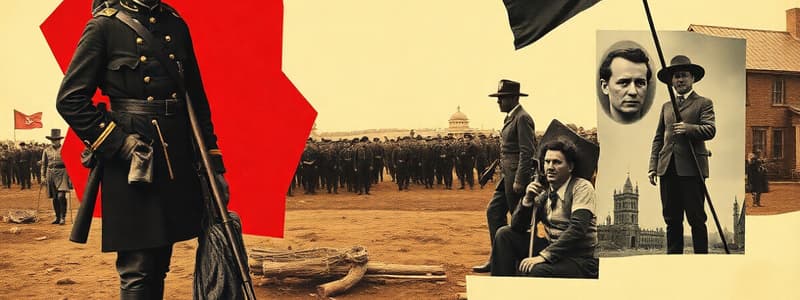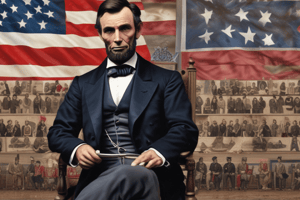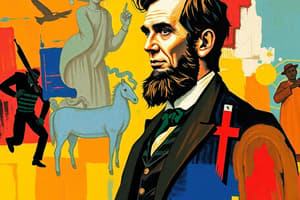Podcast
Questions and Answers
The Anaconda Plan was a Confederate strategy to secure the Mississippi River.
The Anaconda Plan was a Confederate strategy to secure the Mississippi River.
False (B)
Ironclad warships were introduced during the Civil War, making traditional wooden ships obsolete.
Ironclad warships were introduced during the Civil War, making traditional wooden ships obsolete.
True (A)
The Emancipation Proclamation freed all slaves in the United States.
The Emancipation Proclamation freed all slaves in the United States.
False (B)
The Battle of Gettysburg is widely regarded as a decisive Confederate victory, significantly boosting their morale and resources.
The Battle of Gettysburg is widely regarded as a decisive Confederate victory, significantly boosting their morale and resources.
Guerrilla warfare was a tactic used exclusively by the Confederacy.
Guerrilla warfare was a tactic used exclusively by the Confederacy.
Abraham Lincoln, a strong advocate for slavery expansion, was elected President of the United States in 1860.
Abraham Lincoln, a strong advocate for slavery expansion, was elected President of the United States in 1860.
The Civil War led to significant territorial adjustments, changing the boundaries of the United States.
The Civil War led to significant territorial adjustments, changing the boundaries of the United States.
Robert E. Lee, a highly respected general, initially declined an offer to lead the Union army.
Robert E. Lee, a highly respected general, initially declined an offer to lead the Union army.
The 13th Amendment effectively ended slavery in the United States, ending the practice throughout the nation.
The 13th Amendment effectively ended slavery in the United States, ending the practice throughout the nation.
The First Battle of Bull Run (Manassas) was a Union victory that showed the war would be a long and difficult conflict.
The First Battle of Bull Run (Manassas) was a Union victory that showed the war would be a long and difficult conflict.
Flashcards
Total War
Total War
A military strategy targeting enemy armies and civilian infrastructure.
Guerrilla Warfare
Guerrilla Warfare
A tactic using independent groups to attack enemy forces irregularly.
Abolition of Slavery
Abolition of Slavery
The formal ending of slavery in the U.S. through the 13th Amendment.
Reconstruction
Reconstruction
Signup and view all the flashcards
Shift in Gender Roles
Shift in Gender Roles
Signup and view all the flashcards
States' Rights
States' Rights
Signup and view all the flashcards
Economic Differences
Economic Differences
Signup and view all the flashcards
Election of Abraham Lincoln
Election of Abraham Lincoln
Signup and view all the flashcards
Anaconda Plan
Anaconda Plan
Signup and view all the flashcards
Battle of Gettysburg
Battle of Gettysburg
Signup and view all the flashcards
Study Notes
Causes of the American Civil War
- Disagreements over states' rights versus federal authority were a major contributing factor. Southern states believed they had the right to nullify federal laws they deemed harmful to their interests, particularly regarding slavery.
- Economic differences between the North and South fueled tension. The industrial North favored tariffs and a strong federal government to promote economic growth, while the agrarian South opposed tariffs, which hurt their exports.
- The expansion of slavery into new territories was a highly contentious issue. Both sides held deeply entrenched views on the morality and economic viability of slavery, with the South fearing the loss of their labor system if new territories banned slavery.
- The election of Abraham Lincoln in 1860, a Republican opposed to the expansion of slavery, was the immediate trigger for secession. Several Southern states believed that Lincoln's election signaled the inevitable demise of slavery, triggering their decision to leave the Union.
Key Figures and Events
- Abraham Lincoln: President of the United States during the war, known for his commitment to preserving the Union.
- Jefferson Davis: President of the Confederate States of America.
- Robert E. Lee: Highly respected Confederate general, initially offered command of the Union army but chose to fight for the Confederacy.
- Ulysses S. Grant: Union general who eventually achieved victory.
- Fort Sumter: The site of the first battle of the Civil War, where Confederate forces attacked a Union fort in South Carolina.
Major Battles
- First Battle of Bull Run (Manassas): A Confederate victory that demonstrated the war would be a long, hard-fought conflict.
- Battle of Antietam: A significant Union victory that halted Confederate General Lee's advance into Maryland.
- Battle of Gettysburg: Often considered the turning point of the war, heavily impacting the morale and resources of the Confederacy.
- Siege of Vicksburg: A Union victory that secured control of the Mississippi River, splitting the Confederacy in two.
- Battle of Atlanta: A decisive Union victory that hastened the Confederacy's collapse.
Key Strategies and Tactics
- Anaconda Plan: The Union strategy to blockade Southern ports, control the Mississippi River, and slowly squeeze the Confederacy's resources.
- Total War: A strategy used by the Union, involving not only targeting enemy armies but also the economic and social infrastructure of the Confederacy.
- Guerrilla Warfare: Used by both sides, particularly toward the end of the war, involving small, independent groups attacking enemy forces and supply lines.
- Ironclad warships: The introduction of ironclad ships fundamentally changed naval warfare, making traditional wooden ships obsolete.
Key Outcomes and Aftermath
- Abolition of Slavery: The Emancipation Proclamation, issued by Lincoln, declared slaves in Confederate territory free. The 13th Amendment formally abolished slavery throughout the United States.
- Preservation of the Union: The Union ultimately prevailed, preserving the United States as a single nation.
- Reconstruction: The period after the war, during which the South was rebuilt and readmitted into the Union.
- Massive Casualties: The Civil War resulted in a devastating loss of life on both sides and profound social and economic upheaval in the United States.
- Political and Social Change: The war fundamentally reshaped American politics, with the rise of the Republican Party, and irrevocably affected the social fabric of the country, laying the groundwork for future conflicts over racial equality.
Social Impacts
- Increased National Identity: The conflict led to a heightened sense of national identity and unity, although this unity was fragile and racial tensions remained.
- Shift in Gender Roles: Women played prominent roles in the war effort, taking on jobs, managing farms, and supporting soldiers, and this contributed to evolving notions of female roles in society.
- Economic Transformation: The war spurred significant industrial and economic growth in the North, while the South experienced devastating economic damage.
Geographic Impacts
- Territorial Adjustments: The conclusion of the war brought no territorial adjustments, with the borders remaining substantially consistent.
- Political and Social Conflicts: The South's economic and social systems required major restructuring, posing immense challenges and conflicts.
- Military Strategy: The Union's strategy effectively dictated the geography and landscape of the war zones.
Studying That Suits You
Use AI to generate personalized quizzes and flashcards to suit your learning preferences.




